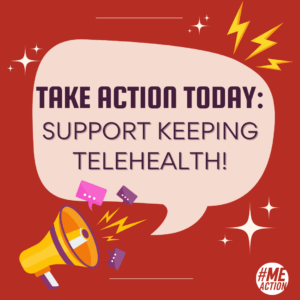Suppose there was a substance that could help you, but before you learned about it, or you could find a doctor to prescribe it, the FDA banned it from the market, even though patients have successfully used it for decades. Or suppose there was a treatment that had helped your function improve from 40 percent to 85 percent and that, one day, the FDA decided that there’s no clinical need, and banned it from the market, leaving you without access to it.
In the absence of an FDA-approved cure for ME, many patients find themselves dependent on compounding pharmacies and compounded treatments.
If you’re not sure if this applies to you, here are four reasons many of us use compounds – do any of these fit you?
- Are you allergic to common ingredients, like lactose, gluten, corn starch, or peanut oil that are in many FDA approved drugs?
- Do you take low-dose naltrexone or ketotifen, neither of which are available as an FDA-approved drug, but are commonly prescribed for ME patients?
- Do you use injectible or IV nutrients, such as B12 or B complex shots, glutathione, vitamin C, or amino acids due to nutrient deficiencies, gut malabsorption, or your genes?
- Are you sensitive to dosing of FDA-approved meds and need a lower dose than in an FDA approved drug?
If you said yes to any of the above, your access to these may be at risk. The FDA is reviewing substances to determine if they are clinically necessary, and they aren’t considering ME patients’ needs into account before deciding to ban substances.
One substance of interest to ME patients is sodium dichloroacetate, known as DCA. A recent Belgian proof of principle study showed that half the ME patients reduced their fatigue by half in the fatigue severity scale. DCA has been on the market for many years and has been used in cancer treatment. The FDA did not consider its use in ME in its recommendation to ban DCA; it noted that there were other FDA approved cancer treatments patients could use instead.
Currently, the FDA Pharmacy Compounding Advisory Committee is in the process of reviewing the following substances and accepting comments until Sept. 11, 2018. These are used in mito cocktails or mast cell activation syndrome, and would include their use in IVs and oral versions without allergens:
– alpha lipoic acid
– pyridoxal 5 phosphate
– CoQ10
– creatine monohydrate
– choline chloride
– quercetin
The FDA has a list of substances they’re scrutinizing in groups of ten. This evaluation will take two steps:
- They’ll investigate whether characteristics of the approved drug may make it unsuitable to treat certain patients for particular conditions, and if it must be made from a bulk compounding substance, or if it could be made from the FDA approved drug. For instance, progesterone in FDA-approved form is formulated with peanut oil, a major allergen. They’d look at the issues with removing the peanut oil, and if doing so would impact the quality of the drug.
- A clinical needs analysis comes next – the FDA will look at each substance’s physical and chemical characteristics, possible or known safety issues, evidence or lack of thereof of effectiveness, and historical use.
The reason that this is changing now is due to a scandal with the New England Compounding Center, who sold contaminated steroids for spinal injection in 2012 — and 76 people died. In the aftermath, Congress tasked the FDA with ensuring the safety of compounded drugs through the 2013 Drug Quality and Security Act. However, there were already laws in place to punish pharmacies who harmed patients through negligence. In January of this year, the pharmacist responsible for the tainted drugs was sentenced to 8 years in prison. These new regulations seem unnecessary at first blush.
Take Action now
ME patients need a voice in this dialog with the FDA. The FDA lacks a representative focused on the needs of ME patients, as they have for cancer patients and other illnesses affecting large numbers of patients. They should be aware of the substances we use and need, and that we are using them in the absence of a cure, under our doctors’ direction, and with careful monitoring.
We are calling on patients to check the list of substances that the FDA is reviewing, and then to write the FDA a note explaining that you use the substance for ME, why the doctor prescribes it, and how it is benefiting you.
Instructions for taking action:
- Check out these lists to see if you use any of the substances on them: List A and List B. (To search for the term within the document, press command + F (Mac) or Control + F (PC) and type in the term.)
- If you do, please write the FDA a short note/email for each substance:
Subject:“503b Compounding – Substance Name”
Email: Explain that you have Myalgic Encephalomyelitis and are using this substance with a doctor’s prescription, why it was prescribed, and the benefits you are getting from it. If you want to, include links to any supporting research – the FDA is swayed by facts. Send it to:
Cindy Chee, PharmD, Designated Federal Officer (DFO)
Division of Advisory Committee and Consultant Management
Office of Executive Programs
Center for Drug Evaluation and Research
Food and Drug Administration
10903 New Hampshire Avenue
Silver Spring, Maryland 20993-0002
Phone: (301) 796-9001
Fax: (301) 847-8533
E-mail: [email protected] - Share this with others, and get them to write in, too.
Restricting Compounding Drugs that are Copies of FDA-approved drugs
Restrictions on compounding drugs is not just about safety. The FDA wants to restrict compounding of drugs that are “copies” of FDA-approved drugs to protect the incentives for pharmaceutical companies to fund R&D and develop FDA-approved drugs. “Copies” refers to drugs that contain the same active ingredient, use the same route of administration (oral, injectable, etc.) and are within 10 percent of the same strength (which they consider to be the case if commercially available tablets can be split, or multiple tablets taken together to reach the prescribed dose). Read more.
If a patient requires a drug that is different from commercially-available products, the compounder will have to prove why it is necessary with a doctor’s prescription that provides specific instructions, such as:
– “No Dye X, patient allergy” (if the comparable drug contains the dye)
– “Liquid form, patient can’t swallow tablet” (if the comparable drug is a tablet)
– “6 mg, patient needs higher dose” (if the comparable drug is only available in 5 mg dose)
“The FDA is further tightening the screws on pharmacies that produce customized medications for individual patients. The agency is inserting itself into the role of “doctor” by deciding for patients whether there is a “clinical need” for certain medicines to be made at pharmacies,” according to the Alliance for Natural Health, who is following this situation. “The very idea that the FDA has the expertise to decide every patient’s “clinical need” is ludicrous—these are decisions that should be left up to doctors and their patients.”






4 thoughts on “Will the FDA Stand in the Way of Your ME Treatment? Take Action now!”
Have sent emails regarding 503B Compounding – Hydroxocobalamin Hydrochloride and another re: Taurine (both of which I get from compounding pharmacies).
I buy allergen-free supplements of many of the other items in the lists (i.e., Ubiquinol, D-Ribose, etc) that are very important to me, but they are not prescriptions. Should we be writing in about these, too? Or only custom made prescription medications?
Also, I cannot seem to get clonazepam made without cornstarch, but I have a delayed sensitivity to corn. Do sensitivities and intollerances count, or do they only care about severe allergies?
Nancy,
I’m glad you are concerned about this too. I’ve seen commercial product formulas change over time, making them off limits to me, so I am concerned about having continued access to each of the substances I need on a continuing basis, whether or not the commercial marketplace offers them.
Like you, I have a corn allergy, and it is very tricky to avoid all the corn derivatives. I count on compounding pharmacies to be able to create formulations that are safe for me to take from the list of bulk compounding substances.
Yes, you should write in in support of any substance on the list that you might find a need for in the future, or it runs the risk of being removed from the marketplace. No compound is an FDA approved drug, though compounds may contain substances used in FDA approved drugs or anything else on the compounding list.
As for food sensitivities and intolerances, what matters is the conversation between you and your doctor, and your doctor’s ability to write a prescription that is safe for you to take without causing unwanted side effects. The FDA does recognize that patients may react differently to the same thing due to individual differences, and therefore allows for this customization to take place.
You also seem to be having the sane experience as I have, not all drugs can be compounded, for various reasons (sourcing, needing the allergen to make the drug work properly, etc.). It’s important to keep a wide range of compounding substances available to offer us as many treatment options as possible.
CoQ10 (ubiquinol) is on the current FDA evaluation list. It would be appropriate to voice support for continued continued access, particularly for patients with mitochondrial disease, which frequently requires high dosing.
Thanks for your interest in this important topic.
FDA
Email sent listing supplements, compounded medications & pharmaceuticals.
I made note in the letter that taking away the substances that aid ME/CFS patients would be like depriving someone of oxygen.
I did write a letter to Ms. Chee with a couple of links from the NIH regarding my 4.5 mg. use of Naltrexone (Low Dose Naltrexone).
Thank you so much for calling this to our attention.
Leigh Prim
Comments are closed.